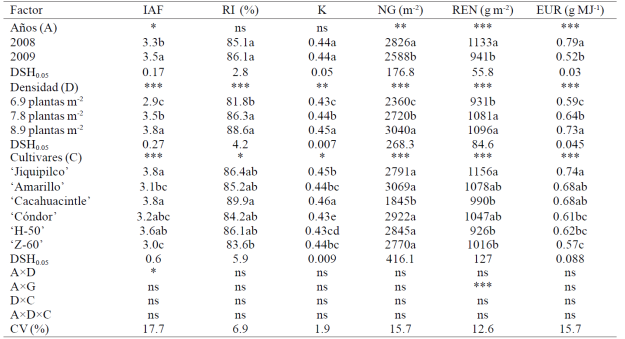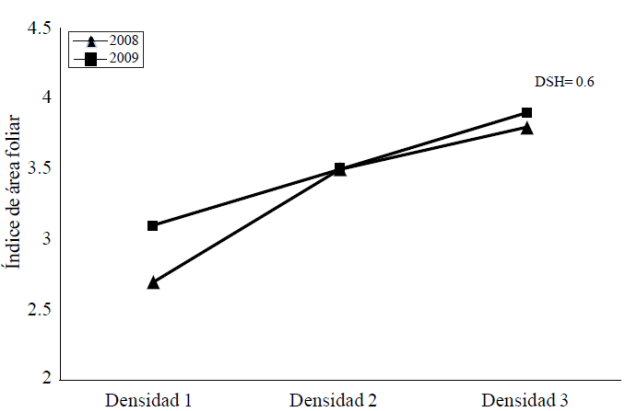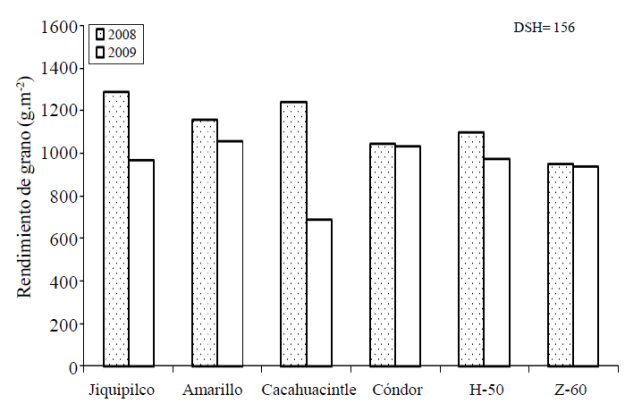Services on Demand
Journal
Article
Indicators
-
 Cited by SciELO
Cited by SciELO -
 Access statistics
Access statistics
Related links
-
 Similars in
SciELO
Similars in
SciELO
Share
Revista mexicana de ciencias agrícolas
Print version ISSN 2007-0934
Rev. Mex. Cienc. Agríc vol.5 spe 8 Texcoco 2014
Investigation notes
Maize population density, light attenuation coefficient and yield
1Ciencias Agropecuarias y Recursos Naturales- Universidad Autónoma del Estado de México. (botmora@colpos.mx).
2Centro de Investigación y Estudios Avanzados en Fitomejoramiento. Universidad Autónoma del Estado de México. Campus Universitario El Cerrillo Piedras Blancas, Municipio de Toluca, Estado de México, C. P. 50200. Tel. 017222965518. Ext. 146. (ofrancom@uaemex.mx; nekkane16@hotmail.com; gaspar@agro.uba.ar; thnm0947@hotmail.com).
During 2008 and 2009 six maize cultivars were evaluated under three population densities in Toluca, Mexico to determine leaf area index, light attenuation coefficient, intercepted radiation, radiation-use efficiency and grain yield. A randomized complete block design in a split-plot arrangement was used, large plots corresponded to the population densities (6.9, 7.8 y 8.9 plants m-2) and the subplots to cultivars ('Amarillo', 'Cacahuacintle', 'Jiquipilco', 'Z-60', 'Cóndor' and 'H-50'). The combined analysis of variance showed significant differences between years, densities and cultivars for all variables, except for light attenuation coefficient and intercepted radiation between years. The interactions were not significant, except in year × density in leaf area index and year × cultivar for grain yield. Among years, the cultivars average yield was higher in 2008 (1 133 g m-2), in 16.9% than 2009, due to the higher number of grains m-2 (2 826) and the radiation-use efficiency (0.79 g MJ-1). The best population densities were 7.8 and 8.9 plants m-2 (average of1 081 and 1 096 g m-2, respectively) equivalent to 13.9% and 15.1% more than with 6.9 plants m-2. The above resulted from the best averages for these population densities in all variables under study. Among cultivars, 'Jiquipilco', 'Amarillo' and 'Cóndor' showed the highest average with 1 156, 1 076 and 1 047 g m-2.
Keywords: Zea mays L.; leaf area index; intercepted radiation; radiation-use efficiency
Durante 2008 y 2009 se evaluaron seis cultivares de maíz bajo tres densidades de población en Toluca, México, con el objetivo de conocer su índice de área foliar, coeficiente de atenuación de luz, radiación interceptada, eficiencia en el uso de la radiación y rendimiento de grano. Se utilizó un diseño de bloques al azar con arreglo en parcelas divididas, las parcelas grandes correspondieron a las densidades de población (6.9, 7.8 y 8.9 plantas m-2) y las subparcelas a los cultivares ('Amarillo', 'Cacahuacintle', 'Jiquipilco', 'Z-60', 'Cóndor'y 'H-50'). El análisis de varianza combinado detectó diferencias significativas entre años, densidades y cultivares paratodas las variables, con excepción del coeficiente de atenuación de luz y radiación interceptada entre años. Las interacciones no fueron significativas, excepto en años × densidades en el índice de área foliar y en años × cultivares para rendimiento de grano. Entre años, el rendimiento promedio de los cultivares fue superior en 2008 (1 133 g m-2), 16.9% a 2009, debido al mayor número de granos m-2 (2 826) y a la eficiencia en el uso de la radiación (0.79 g MJ-1). Las mejores densidades de población fueron 7.8 y 8.9 plantas m-2 (rendimiento promedio de 1 081 y1 096 g m-2, respectivamente) equivalente a 13.9% y 15.1% más que con 6.9 plantas m-2. Lo anterior fue consecuencia de los mejores promedios presentados por estas densidades de población en todas las variables bajo estudio. Entre cultivares, 'Jiquipilco', 'Amarillo' y 'Cóndor' presentaron el rendimiento promedio más alto con 1 156, 1 076 y 1 047 g m-2.
Palabras clave: Zea mays L.; índice de área foliar; radiación interceptada; eficiencia en el uso de la radiación
Maize (Zea mays L.) in Mexico is the leader among the grains by the total crop area and consumption habits of Mexican people. Harvested in 7.34 million hectares, with an average yield of 3.3 t ha-1 (Gonzalez et al, 2007). In order to increase yield of this cereal grain, it is important to increase the amount of intercepted radiation (IR) which depends on the cultivar used, population density and developmental stage. In order to achieve high IR levels it is necessary to generate a high maize leaf area index (LAI) from early developmental stages (Maddonni and Otegui, 1996). An optimum LAI is one with maximum dry matter production, and is reached when the lower canopy strata can maintain a positive carbon balance, i.e. when the crop absorbs all the photosynthetically active radiation (PAR) (Diaz et al., 2011).
The increase in population density allows for greater coverage in advance within the crop cycle, which leads to more biomass. In general, the relationship between total dry matter production per area unit and plant density is asymptotic because after a certain density value, the contribution of additional plants causes a reduction in their individual weights by increased competition among them (Andrade et al, 2002).
Furthermore, the light attenuation coefficient (k) indicates the degree of decrease of this factor due to light absorption and distribution of within the canopy. In erectophile canopies, the leaf insertion angle with respect to the stem (45°) k ranges from 0.3 to 0.5, while in canopies with planophile leaves, k will be 0.7, indicating that the upper canopy has absorbed 70% ofthe incident radiation. Finally, the radiation-use efficiency is the amount of dry matter or yield per unit of radiation intercepted by the crop. The PAR intercepted by the crop becomes biomass, thus the slope of the linear relationship between both variables represents the radiation-use efficiency (RUE). When the biomass of interest is the maize grain yield, the RUE ranges from 1 to 1.4 g MJ-1 (Birch et al., 1999). Therefore, in the present investigation six maize cultivars were evaluated in 2008 and 2009 under three population densities in Toluca, Mexico, in order to determine their leaf area index, light attenuation coefficient, intercepted radiation, radiation-use efficiency and grain yield, to recommend the best maize cultivar for the study area.
The research was carried out in Toluca, Mexico (19° 24' north latitude, 99° 54' west longitude, 2 611 m altitude). The climate type is C (w2) (w) bi (García, 2005), corresponding to sub-humid temperate with summer rains and low rainfall in winter (5%). The average annual rainfall is 900 mm, average annual temperature 12.8 oC, the soil type is clayish (34%) with pH 6.6 and organic matter content of 1.95 % (Morales et al., 2011). In both years, three open-pollinated landraces commonly used in the region ('Amarillo', 'Cacahuacintle' and 'Jiquipilco') were evaluated and three hybrids recommended for this area, of intermediate cycle (90 to 100 days to male flowering) single cross hybrid 'Z-60', three-line hybrid 'Cóndor' and double cross hybrid 'H-50' (González et al, 2007). Planting was performed on April 9th (2008) and onApril 10th (2009) manually, three seeds per hole, thinning to one plant at the stage of four fully expanded leaves.
The distance between plants to achieve the appropriate density for each treatment (6.9, 7.8 and 8.9 plants m-2) was 18, 16 and 14 cm, respectively. For data analysis, a factorial split plot design was used, where the main plots corresponded to the population densities (6.9, 7.8 and 8.9 plants m-2) and the subplots to the cultivars ('Amarillo', 'Cacahuacintle', 'Jiquipilco', 'Z-60', 'Cóndor' and 'H-50'). Treatments were distributed through a randomized block design with three replications. The experimental unit consisted of five rows 5 m long, spaced at 80 cm, the useful plot comprised only the three inner rows. After planting the 90-90-46 formula with urea, triple calcium superphosphate and potassium chloride was applied as sources, respectively, and 90 kg N ha-1 (urea) at hilling, 40 days after planting (dap). In both years the experiments were established with irrigation in planting, completing crop water needs with rainfall in the rainy season. Herbicide (atrazine 1 L ha-1) was applied in post-emergence at 25 dap.
Variables subjected to statistical analysis were: 1) leaf area (LA), in each treatment five plants from the useful plot were cut at male flowering of each cultivar, leaves were measured with a Li-Cor 3100 leaf area meter the average was determined and expre ssed in cm-2; 2) Leafarea index by the formula LAI = (LA) (PD) / PA, where PD is plant density and PA is planted area (Morales et al, 2011); 3) number of grains (NG, m-2), upon harvest, the number of grains in 10 ears was counted and the average was determined; and 4) grain yield (YLD, g m-2), grain weight of 10 ears with 14 % moisture and the average was obtained. At the Weather Station of the Faculty of Agricultural Sciences UAEMex, located in the study area, the maximum temperature (Tmax), minimum (Tmin), average (Tavg), precipitation (PPT) and incident global radiation (GR) were recorded during the crop growth stage, in both years. The crop intercepted radiation (IR); expressed in (%) was measured at male flowering of each treatment with a Li-Cor 191 linear sensor.
This variable was measured at solar noon at ground level. The radiation-use efficiency (RUE) was expressed in intercepted g MJ-1 by the formula: RUE = (YLD/PAR) (IR), where YLD is grain yield (g m-2), PAR is photosynthetically active radiation accumulated until crop male flowering (MJ m- 2) and IR is percentage of radiation intercepted by each treatment. The light attenuation coefficient (k) was determined at male flowering according to Beer's law: F= 1 -exp (-k LAI), where F is the fraction of intercepted radiation, and k is the light attenuation coefficient. Acombined analysis of variance was performed including the two years of study, population densities and cultivars and mean comparisons by the Honest Significant Difference (p< 0.05) using the SAS Proc GLM statistical package (SAS Institute, 2004).
The average temperature for 2008 was 13.5 °C and in 2009 was 14.6 °C, in both years the minimum temperature ranged from 4.5 to 11 oC and the maximum from18.4 to 26.1 oC. Rainfall during the 2008 growing season was 908 mm, of which 451 mm occurred in the vegetative stage and 457 mm from anthesis to physiological maturity. In 2009 rainfall in the growing season was 789 mm, of which 292 mm (37%) fell during the vegetative stage and 497 mm (63%) during the grain filling stage. In 2008, it rained 13.1% more than in 2009, thus in that year maize grain yield was higher compared to 2009. According to Tollenaar and Aguilera (1992), YLD is influenced by weather conditions, which can vary from one crop cycle to the next.
Table 1 shows significant differences between years, densities and cultivars for all variables, except for k and IR between years. Interactions were not significant, except for years by densities (Y×D) in LAI and years by cultivars (Y×C) in YLD. This shows similar cultivar behavior between years and densities. The variation coefficient (%) was 1.9 for k and 17.7 for LAI. Cultivars yield was higher in 2008 (1 133 g m- 2) 16.9% more than in 2009, probably due to higher average number of grains m-2 (2 826) and radiation-use efficiency (0.79 g MJ-1).
The best population densities (PD) were 7.8 and 8.9 plants m-2 (average yield of 1 081 and 1 096 g m-2 respectively) equivalent to 13.9 % and 15.1 % more than with 6.9 plants m-2. This could be based on the best averages shown by these population densities in the LAI, IR, k, NG and RUE variables (Table 1). These results do not agree with Cano et al. (2001) since in an experiment where fertilization and population density effect was studied in maize under rainfed conditions, the maximum yield was found with a density of 6.3 plants m-2 (520-670 g m-2). However, Soltero et al. (2010) reported that maize grain yield increased from 1 464 to 1 534 g m-2, varying from 7.5 to 10.5 the number of plants m-2. Results from this study suggest an optimal plant density for these genotypes at about 7.8 plants m-2.
Concerning k, the lowest population density showed the best average (0.43) (Table 1), the interpretation given to this value is that 43% of the intercepted radiation remains in the upper stratus of the plant and 57% is attenuated in the lower strata (Montemayor et al., 2006; Díaz et al, 2011). In our study, at the highest population densities, the k average ranged from 0.44 to 0.45, thus there was a little less light penetration in the middle and lower strata relative to the lowest density. Diaz et al. (2011) in an experiment evaluating phosphorus influence on k in maize in the Toluca valley, found higher values than those reported in our research for 'Cacahuacintle' 'Amarillo'' and 'Cóndor' of0.57, 0.52 and 0.62, respectively, with a density of 7.2 plants m-2, the differences in k are attributed to the estimation time, as these authors calculated them 95 days after planting.
Table 1 Analysis of variance and mean separation of three planting densities and six maize cultivars evaluated in 2008 and 2009.

*** p≤ 0.001, **p≤ 0.01, *p≤ 0.05, ns: diferencias no significativas; Columnas con la misma letra en cada factor de estudio son estadísticamente iguales (p< 0.05); DSH=diferencia significativa honesta; CV= coeficiente de variación
Among the cultivars, the YLD for 'Jiquipilco' (1 156 g m-2) exceeded 'Amarillo' (1 078 g m-2) and hybrids including 'Cóndor' (1 047 g m-2). This was because this landrace showed the highest LAI and RUE values (3.8 and 0.74 g MJ-1, respectively) and an acceptable IR value (86.4 %). The YLD for 'Amarillo' and 'Cóndor'' was similar and surpassed Z-60 (1 016 g m-2), 'Cacahuacintle' (990 g m-2) and 'H-50' (926 g m-2). This was due to higher NG per area unit (3 069) and RUE (0.68 g MJ-1) of 'Amarillo' and the best k (0.43) and NG (2 922 m-2) of 'Cóndor'. In contrast to this research, Martínez et al. (2010) found a lower NG in 'Cóndor' under rainfed conditions in Toluca, Mexico under at two planting dates (11-04-2008 and 01-05-2008) which ranged between 1 670 and 2 150 grains m-2, respectively.
The Y × D Interaction for LAI shows that in 6.9 plants m-2 ranged from 2.7 (2008) to 3.1 (2009), and with 7.8 plants m- 2 was the same (3.5) in both years and with 8.9 plants m-2 ranged from 3.8 (2008) to 3.9 (2009), this indicates that in the last two densities LAI had a similar pattern in both crop cycles (Figure 1).

Figure 1 Interaction year × plant density evaluated in 2008 and 2009. Density 1, 2 and 3 = 6.9, 7.8 and 8.9 plants m- 2, respectively.
The Y × C significant interaction in maize for YLD (Figure 2) was due to the 'Jiquipilco' and 'Cacahuacintle' marked response which changed from 2008 to 2009, as their yield increase in2008was higherthan in'Amarillo','Cóndor','H-50' and 'Z-60'. However, in 2009 'Cacahuacintle'YLD dropped remarkably with respect to the other cultivars. On average, the 'Z-60' hybrid showed the lowest yield potential.
Figure 2 shows that landraces production dropped in 2009 (mainly due to lower rainfall), although this trend was lower in 'Amarillo'(1 160.6 gm-2 in 2008 and 1 054.9 g m-2 in 2009). Hybrids had a consistent behavior in both years, highlighting 'Cóndor' with 1 049.3 to 1 033.6 g m-2 in 2008 and 2009 respectively, consistent with Montemayor et al, 2006.
Literatura citada
Andrade, F.; L. Echarte, R.; Rizzalli, and Casanovas, M. 2002. Kernel number prediction in maize under nitrogen or water stress. Crop Sci. 42:1173-1179. [ Links ]
Birch, C.; Hammer, G. and Ricker, K. 1999. Dry matter accumulation and distribution in five cultivars of maize (Zea mays): relationships and procedures for use in crop modeling. Aus. J. Agron. Res. 50:513-527. [ Links ]
Cano, O.; Tosquy, O. H.; Sierra, M. y Rodríguez, F. A. 2001. Fertilización y densidad de población en genotipos de maíz cultivados bajo condiciones de temporal. Agron. Mesoam. 12:199-203. [ Links ]
Díaz, L. E.; Morales, R. E. J.; Franco, M. O. y Domínguez, L. A. 2011. Coeficiente de atenuación de luz, radiación interceptada, biomasa y rendimiento de maíz en función del fósforo. Terra Latinoamericana 29: 65-74. [ Links ]
García, E. 2005. Modificaciones al sistema de clasificación climática Koppen. Talleres Larios. México, D. F. 220 p. [ Links ]
González, H.A.; Sahagún, C. J.; Pérez, L. D. J.; Domínguez, L.A.; Serrato, C. R.; Landeros, F, V. y Dorantes, E. 2007. Diversidad fenotípica del maíz Cacahuacintle en el valle de Toluca, México. Rev. Fitotec. Mex. 29:255-261. [ Links ]
Maddonni, G. and Otegui, M. 1996. Leafarea, light interception and crop development in maize. Field Crops Res. 48:81-87. [ Links ]
Martínez, R. C. G.; Estrada, C. G.; Beltrán, G. V.; Ortega, R. G.; y Contreras, R. A. 2010. Contenido de agua en el grano y capacidad potencial de demanda en híbridos de maíz para valles altos. Rev. Fitotec. Mex. 33:95-100. [ Links ]
Montemayor, A.; Zermeño, A.; Olague, A.; Aldaco, R.; Fortis, M.; Salazar, E.; Rodríguez, C. y Vázquez, C. 2006. Efecto de la densidad y estructura del dosel de maíz en la penetración de la radiación solar. Oyton 75:47-53. [ Links ]
Morales, R. E. J.; Franco, M. O. and González, H. A. 2011. Snap bean production using sunflowers as living trellises in the central high valleys of Mexico. Ciencia e Investigación Agraria 38(1): 53-63. [ Links ]
Statistical Analysis System (SAS Institute). 2004. SAS/STAT User's Guide, Version 8.02. SAS Institute, Inc. Cary NC, USA. 479 p. [ Links ]
Soltero, D. L.; Garay, L. C. y Ruíz, C. J. A. 2010. Respuesta en rendimiento de híbridos de maíz a diferentes distancias entre surcos y densidad de plantas. Rev. Mex. Cienc. Agríc. 1:149-158. [ Links ]
Tollenaar, M. and Aguilera, A. 1992. Radiation use efficiency of and a new maize hybrid. Agron. J. 84:536-541. [ Links ]
Received: February 2014; Accepted: March 2014











 text in
text in 



